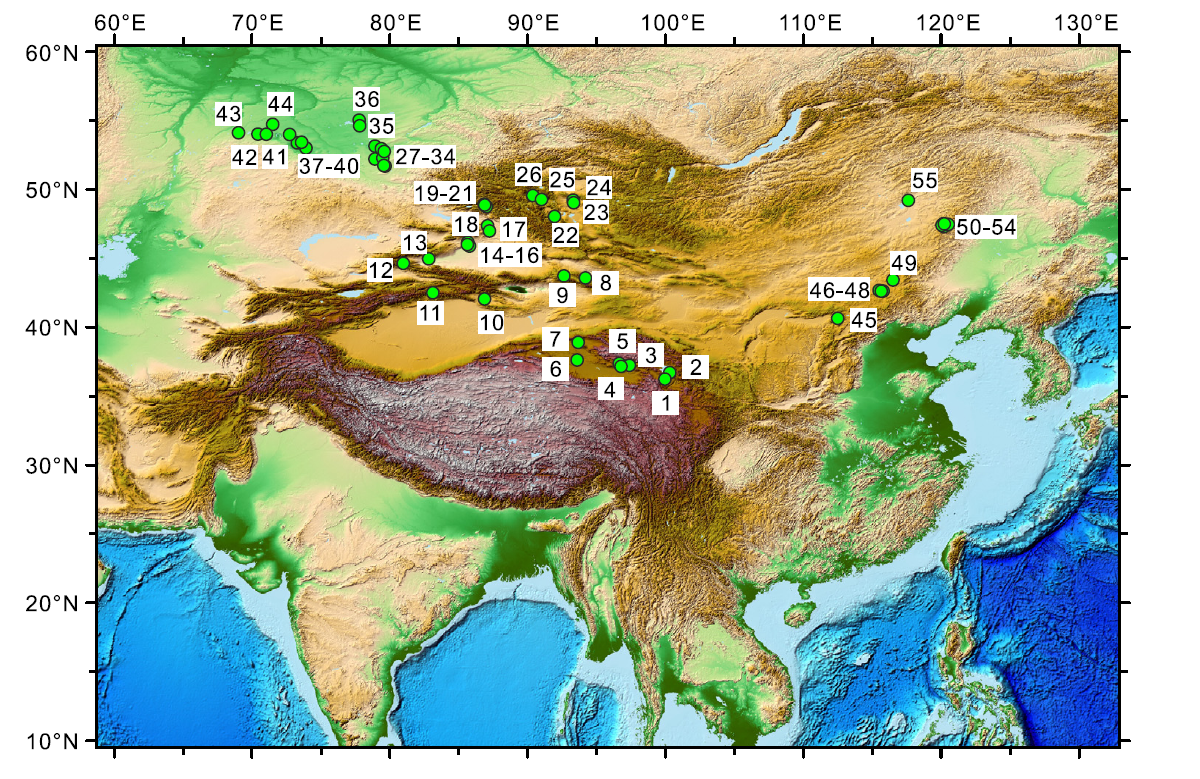Editor: 邵丹蕾 Author: HE Yuxin Time: 2020-06-01 Number of visits :292
Lake water salinity, an important indicator of lake hydrological conditions, is critical to deciphering terrestrial paleoclimatic and paleoenvironmental changes. By far, reconstruction of lake water salinity remains challenging as limited lake salinity indicators have shown to be universally valid for mid-latitude Asia, asking for development of novel salinity proxies with more broad applications. The proportion of C37:4 alkenone to total C37 alkenones (%C37:4) and the relative abundance of archaeol to caldarchaeol (ACE) are promising salinity indices in lacustrine settings. However, developing regional calibrations for both indicators is challenging due to limited datasets and a poor understanding of the factors that influence them.

Fig. 1. Geographic locations of the 55 investigated lakes in mid-latitude Asia.
In this study, He et al. (2020) investigated the two salinity indicators in the same lake sediment samples from mid-latitude Asia (Figure 1). In the whole dataset, the %C37:4 values show a complicated relationship with salinity. In addition to %C37:4 changes, the species-associated occurrence of C37:3 alkenone isomer and substantial changes in the C37/C38 ratio (with or without species changes) may be also adaptive strategies that alkenone producers use to respond to freshening conditions. Seasonal bias in alkenone production could further obscure the %C37:4-salinity relationship. A stronger relationship emerges after removing samples influenced by these factors (Figure 2).
The ACE values show a strong positive corre-lation with salinity (Figure 3). However, substantial deviations of the ACE values in low salinity range (<60,000mg/L) and majority of ACE changes at the salinity range of 60,000–100,000mg/L suggest that the ACE index primarily responds to Euryarchaeota/Archaea com-munity changes when a salinity threshold is crossed. Therefore, the ACE index might not be sensitive enough to track salinity variation in fresh and brackish lakes.

Fig. 2. Correlation of %C37:4 with lake water salinity from the 55 investigated lakes in mid-latitude Asia.

Fig. 3. Correlations of the ACE index with lake water salinity from the 55 investigated lakes in mid-latitude Asia.
The two lake salinity indicators show great potential to be used for past salinity changes. However, for down-core reconstructions, their influencing factors as identified here need to be constrained as much as possible and careful consideration of those is required before applying the two salinity indicators. This study also highlights the power and the promise of having both proxies in the same sample to further refine the salinity reconstruction, as the two independent proxies are derived from biomarkers produced by different biological organisms and influenced by different factors.
For Details: He, Y., Wang, H., Meng, B., Liu, H., Zhou, A., Song, M., Kolpakova, M., Krivonogov, S., Liu, W., Liu, Z., 2020. Appraisal of alkenone- and archaeal ether-based salinity indicators in mid-latitude Asian lakes. Earth and Planetary Science Letters. 538, 116236.https://www.sciencedirect.com/science/article/pii/S0012821X20301795
